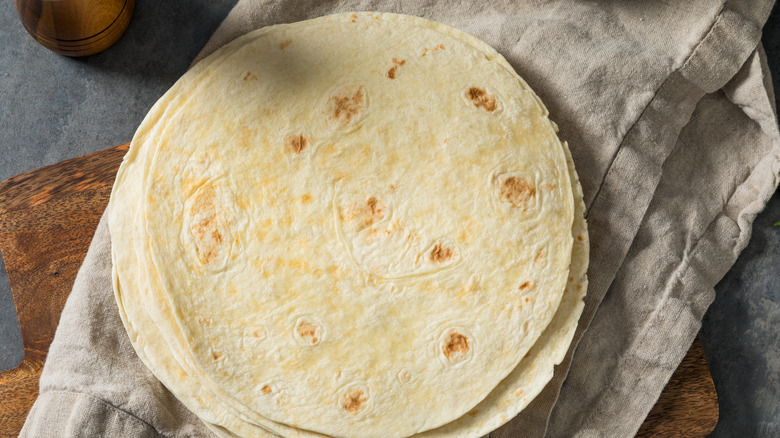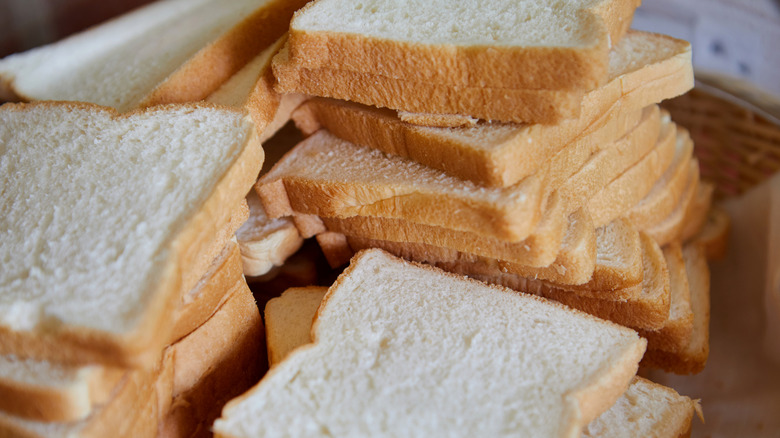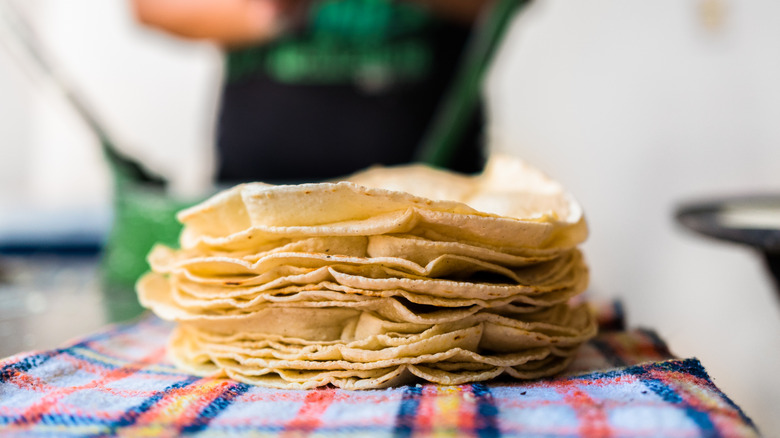Tortillas Vs White Bread: How They Compare
Wherever you are in the world, every global cuisine has its carb-heavy staple food. In the United States, two of the bases that make up many meals are bread and tortillas. Both are versatile pantry staples, best to always have on hand to whip up a quick meal whenever needed. But nutritionally speaking, how do they stack up?
To understand the macro makeup and calorie count, it's best to break down first what these are made from. For white bread, refined wheat flour is the primary ingredient, which is flour that has been bleached and stripped of nutrients and fiber, giving it that pure white color. White bread purchased from grocery stores typically also includes water, sugar, vegetable oil, salt, dough conditioners (to soften the bread), yeast, and a mix of vitamins like folic acid, iron, and niacin. These are mixed in because the flour has been stripped of its nutrients. To ensure white bread doesn't go bad in a matter of days, preservatives are also added. And if you don't have a favorite brand yet, Mashed has a few recommendations for the best white breads to buy from the grocery store.
Flour tortillas typically contain fewer ingredients and are also made from refined wheat flour, salt, baking powder, preservatives, water, and a fat, like vegetable oil. Homemade flour tortillas may contain manteca, or lard, for the fat. Corn tortillas, on the other hand, are the simplest of the three, typically just made from masa harina, a corn flour that has gone through nixtamalization. This process, which dates back to the Aztecs in pre-Cortez Mexico, involves treating raw corn with limewater to unlock nutrients like niacin and improve digestibility. Store-bought corn tortillas that are not refrigerated may contain preservatives.
Comparing serving size and calories of bread and tortillas
If you're watching your calorie intake or are just curious how these staples stack up, know that the serving size does vary between white bread and tortillas. One bread slice does not equal one tortilla. For white bread, a standard serving is one slice, which adds up to 70 to 80 calories depending on the brand. Some denser slices may be closer to 140 calories per slice. That's what you can expect if you decide on a single slice of toast for breakfast. But for a sandwich with two slices of bread, you'd be looking at around 140 to 280 calories.
Flour tortillas have a bit more variety in terms of size. An average medium tortilla (8-inch) has about 140 to 160 calories, which largely comes from the added fat content. Larger burrito-sized versions (10 to 12 inches or more) can be as much as 200 to 300 calories each. It's easy to not realize how calorie-dense flour tortillas are, especially since visually, they're much thinner than bread.
Corn tortillas offer a lighter alternative: One small corn tortilla (6-inch), often used for street food tacos, usually has about 50 to 60 calories. You're normally going to be eating more than one of these, but two or three would still keep it under 200 calories. There are larger corn tortilla sizes as well, from 6 to 8 inches, which might be used for a quesadilla and add up to around 70 calories each.
Comparing macros and fiber of bread and tortillas
Calories don't tell the whole story of nutritional content — there's also fiber, fat, and protein. In terms of fiber, corn tortillas come out on top. This is the only option with the whole grain base, masa harina, and two small corn tortillas can provide around 3 to 4 grams of fiber. Flour tortillas, on the other hand, tend to be lower in fiber with 1 to 2 grams per tortilla. White bread doesn't offer much, typically with 1 gram per slice (unless it has been fortified).
For the macros, a flour tortilla has 26 grams of carbohydrates, a slice of bread has 18, and a corn tortilla has 11 grams. None of these carb-heavy staples is really protein-rich, but each offers a few grams, and this can add up when paired with fillings like beans or meat. One slice of white bread has around 2 to 3 grams of protein, a medium flour tortilla typically has 4 to 5 grams, and two corn tortillas come in at about 1 to 2 grams total. These options are also not a high source of fat, with all falling under 3 grams of fat.
If you want a less processed, lower-calorie base for your meal with more fiber, corn tortillas are the top choice. Flour tortillas and white bread are similar nutrition-wise, and are more processed foods. Which you choose from these really just depends on what cuisine you're in the mood for. If you want to make a homemade version, know that tortillas will be the quicker, low-fuss option, as the masa (dough) doesn't need to rise like bread — but you'll need to get a tortilla press. Ultimately, all three can have a place on your plate, but it just depends on what your diet and what your cravings call for.


